Guest Blogged by Ernest A. Canning
Part I of a Five-Part Special Series
(Part II is now here. Part III is now here. Part IV is now here. Part V is now here.)
"When any modern state tortures even a few victims, the stigma compromises its majesty and corrupts its integrity. Its officials must spin an ever more complex web of lies that, in the end, weakens the bonds of trust and the rule of law that are the sine qua non of a democracy. And, beyond its borders, allies and enemies turn away in collective revulsion." - Prof. Alfred W. McCoy, A Question of Torture (2006).
 Truth and justice are essential components of democracy and the rule of law. We cannot move forward unless we honestly examine our past. Accuracy is vital to every decision we make, be it impeachment, prosecution or a restoration of our nation’s honor and integrity.
Truth and justice are essential components of democracy and the rule of law. We cannot move forward unless we honestly examine our past. Accuracy is vital to every decision we make, be it impeachment, prosecution or a restoration of our nation’s honor and integrity.
This is the first in a five-part series of articles which will strive to correct misperceptions arising from the erroneous blending of military and CIA torture. This task has become especially relevant now that the Justice Department's the Office of Legal Counsel (OLC), the very section which had issued the torture memos, tasked by former Attorney General Michael Mukasey with investigating itself, has now released a recommendation that none of the authors of the torture memos be prosecuted. This recommendation stands in stark contrast to our nation's post-World War II decision to prosecute German judges for war crimes at Nuremberg.
Part I addresses the relatively public involvement of the U.S. military and private contractors at Guantanamo, Afghanistan and Iraq. It will dispel the notion that the Bush White House sought out independent legal opinions from the OLC before deciding to torture.
Part II will discuss the CIA's dark beginnings, including its recruitment of former Nazis, its devotion to covert "psychological operations" as a founding principle, the experiments on unwitting subjects that were part of a maniacal quest to crack the code of human consciousness, and the scientific studies that led to KUBARK, the CIA's torture manual.
Part III provides a vital historical account of CIA torture applied by surrogates in developing nations as a component of empire, an account that belies the suggestion made by the The New York Times that CIA torture first arose as an aftermath of 9/11.
Part's IV and V will address the CIA's involvement in extraordinary rendition and an ultra-secret system of “black-sites” into which “ghost detainees” would disappear. It will show how the techniques used on "ghost detainees" are the culmination of a half-century of CIA research and practices...
Military Torture
The 263-page Senate Armed Services Committee Report [PDF] (the “Levin Report”), whose release was inexplicably delayed from its Nov. 20, 2008 completion to April 22, 2009, tracks the military’s involvement* in torture. It reveals that in December 2001, more than a month prior to the issuance of a Feb. 7, 2002 Presidential memorandum, erroneously** declaring that the Geneva Convention's proscriptions on torture did not apply to al Qaeda and Taliban detainees, the DoD’s Office of General Counsel “solicited information on detainee "exploitation" from the Joint Personnel Recovery Agency (JPRA), the “agency that oversees military Survival Evasion Resistance and Escape (SERE) training,” whose techniques are [emphasis added] “based, in part, on Chinese Communist techniques used during the Korean war to elicit false confessions.”
In the SERE program U.S. military personnel, under careful medical controls, are taught to resist unlawful interrogation practices (aka torture). SERE techniques include forced nudity, stress positions, hooding, sleep disruption, loud music and flashing lights, exposure to extreme temperatures, face and body slaps and, in the Navy's SERE school, waterboarding.
The Levin Report discusses how SERE techniques were “reverse engineered” for use at Guantanamo, by the U.S.. This was approved at the highest levels of the Bush/Cheney cabal,*** despite multiple legal memoranda from all branches of the armed forces challenging its legality and despite a July 2002 JAPRA memo which noted that aside from its “myriad legal, ethical, or moral implications,” torture produces unreliable intelligence. The Levin report reflects modification of the SERE techniques to exploit fear, such as the use of vicious dogs. Levin includes an historical account of how these modified and reverse engineered SERE techniques migrated from Guantanamo to Afghanistan and Iraq.
The Levin report contains neither an in-depth analysis of the CIA history and application of torture nor the CIA’s role in extraordinary rendition and methods that were exclusive to “ghost detainees.” Levin does not address the role of private contractors, like CACI International Inc. and Titan Corp. (now L-3 Services), named in lawsuits brought by the Center for Constitutional Rights ("CCR"), Al Shimari v. CACI and Saleh v. Titan. The CCR alleges the companies engaged in torture while providing interrogation and translation services at Abu Ghraib.
_____
**In Hamdan v. Rumsfeld (2006) the Supreme Court rejected the Administration's position. Common Article 3 of the Geneva Conventions, which mandates that all detainees “in all circumstances be treated humanely” and which proscribes “outrages upon personal dignity, in particular, humiliating and degrading treatment” applies to al Qaeda and the Taliban.
***Rumsfeld, who signed a Dec. 2002 memo authorizing torture at Guantanamo, displayed a despicable cowardice by asserting the emerging Abu Ghraib torture photos were the work of “a few bad apples.” Today, as low level former MPs languish in military prisons because of their role in carrying out those policies he specifically approved, Rumsfeld walks about, a free and wealthy man.
Legal Fig-Leaves
President Obama’s initial rush to shield CIA torturers on the basis of their supposed reliance on the quasi-legal memos overlooked a critical issue, now partially resolved by a newly released summary [PDF] sent by Sen. John D. Rockefeller, IV to Attorney General Eric Holder for a declassification review. It reveals that Abu Zubayda was “badly injured in the firefight that brought him into custody” in March 2002; that he was initially interrogated by FBI agents while receiving medical care; that contacts in which the CIA sought NSC approval for application of its torture techniques began in April 2002 and that the National Security Advisor authorized application of CIA torture techniques, “subject to a determination of legality by” the OLC.*
The Levin Report reflects that the torture memos were issued by the OLC’s Jay Bybee only “after consultation with senior Administration attorneys, including then White House Counsel Alberto Gonzales and then-Counsel to the Vice President David Addington.”
This seemingly innocuous notation says a great deal. As revealed by Jane Mayer’s July 3, 2006 New Yorker article, "The Hidden Power,” the former Vice President and his chief legal counsel (who later became Cheney's chief of staff), David Addington were the driving force behind the Bush regime's unprecedented claims of dictatorial executive powers.
Addington, a man described by Lawrence Wilkerson, Secretary of State Colin Powell’s former assistant, as “utterly ruthless,” began his government career as assistant CIA general counsel where he aided William Casey’s resistance to Congressional oversight. He served as a staff attorney on the U.S. House/Senate select committee investigating the Iran/Contra scandal, assisting Congressman Richard Cheney in preparation of the Iran-Contra Minority Report. Although the scandal produced 17 felony convictions, the Minority Report, Mayer observes, made the “outlandish” claim it was “Congress --- not the President --- [which] had overstepped its authority, by encroaching on the President’s foreign-policy powers.”
According to Mayer, Addington dominated the agenda. She quoted an administration source: “’If you’re not sufficiently ideological, he would cut the ground out from under you.’” Former Pentagon lawyer Richard Schriffrin described a tense multi-agency White House meeting in which Addington would simply dismiss them. “He didn’t recognize the wisdom of the other lawyers. He was always right...He knew the answers...If you favored international law, you were in danger of being called ‘soft on terrorism.’” Mayer said a number of “talented top lawyers who challenged Addington...left the Administration under stressful circumstances.”
As we observed previously in "Prosecute or Perish," Addington was well aware that innocents were being held at Guantanamo. He didn’t care.
Addington, Bybee and DoD General Counsel William J. Haynes were included amongst the six Bush administration attorneys who were targeted by Spanish prosecutors in the war crimes complaint they filed with Judge Baltasar Garzón. The Levin Report reveals that Haynes quashed a review by “then-Captain (now Rear Admiral) Jane Dalton, Legal Counsel to the Chairman of the Joint Chiefs of Staff” which “discussed the military services' concerns” about application of reverse engineered, SERE techniques to detainees.
The evidence is compelling. The President and Vice President wanted torture. They had no intention to leave little matters like international and federal laws forbidding torture to stand in the way. The notion that they relied on legal opinions from an independent OLC is a farce. Any doubts about that were conclusively resolved when the White House sought to collect and destroy all copies of a dissenting legal memo from former State Department attorney Philip Zelikow.
_____
Premature Exculpation
In his haste to evade his obligation to faithfully execute the law with respect to those who supposedly relied upon the OLC legal opinions, President Obama not only ignored the long history of CIA torture that will be addressed in subsequent articles, but the significant issue of whether, in terms of the Bush regime's so-called "war on terror," the CIA was already engaged in torture and sought the OLC opinions as a retroactive justification for crimes already committed.
Where the Aug. 2002 Bybee torture memo suggests that the CIA was seeking OLC approval "before" it tortured Abu Zubaydah, there is reliable evidence that Abu Zubaydah was subjected to torture long before Bybee conjured his now infamous memos.
Abu Zubaydah initially cooperated with FBI agents, one of whom tended to his wounds. But the CIA, which would later destroy some 92 interrogation tapes, insisted on taking over the interrogation. After Zubaydah was transferred to a CIA black site, the two FBI agents complained about "brutal tactics." They were told the tactics had been approved "at the highest level."
It is likely that Zubaydah was not the first Bush-era victim of CIA torture. In 2001 John Walker Lindh, “The American Taliban,” was captured by the Northern Alliance and taken to a courtyard inside a Northern Alliance fort where he was “brutally” questioned by two CIA agents. This sparked a riot that resulted in the death of the CIA’s Michael Spann. Recaptured, Lindh was transferred to Bagram Airbase, by which time he was “dehydrated, starving, and suffering from a festering bullet wound in his leg.” He was then “duct-taped to a gurney, blindfolded with tape, and left in a dark, sealed, unheated metal shipping container….His leg was left untreated for days. Allegedly tortured…he was repeatedly threatened with death and…when he asked for a lawyer,” Lindh was told “nobody knows you’re here.” He “cracked and signed a confession.” D. Lindorf & B. Olashansky, The Case for Impeachment (2006)
Lindorf & Olshansky reveal that, after his return to the US, Lindh’s family hired attorney James Brosnahan, who moved to suppress the confession, seeking to call as witnesses both soldiers from Bagram and Guantanamo detainees. Faced with possible revelations of CIA torture, Michael Chertoff, then the head of the Justice Department’s criminal division, offered a plea arrangement in which the government would drop the terrorism, attempted murder and conspiracy to kill Americans charges if Lindh would plead guilty to the charges of providing assistance to a banned country and carrying a weapon. Chertoff's offer required that Lindh “sign a letter saying he had ‘never been mistreated.’”** Lindh accepted
_____
**I mentioned in an earlier post that the day after my father was waterboarded during WWII, and forced to sign a false confession that he was a British agent, the Japanese Kempetai, unsatisfied by his wobbly signature, gave him the choice of again signing or undergoing another round of waterboarding. I neglected to mention that, at that time, my father was given a second document that stated he'd signed the first of his own "free will." What is it about people who torture that makes them insist the victim sign off on the lie that their victim had "never been mistreated"?
===
Ernest A. Canning has been an active member of the California State Bar since 1977 and has practiced in the fields of civil litigation and workers' compensation at both the trial and appellate levels. He graduated cum laude from Southwestern University School of Law where he served as a student director of the clinical studies department and authored the Law Review Article, Executive Privilege: Myths & Realities. He received an MA in political science at Cal State University Northridge and a BA in political science from UCLA. He is also a Vietnam vet (4th Infantry, Central Highlands 1968).


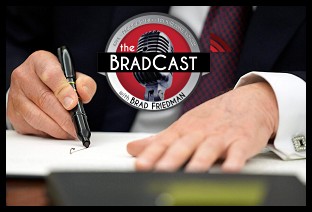 Trump's Day 1 Assault on America: 'BradCast' 1/21/25
Trump's Day 1 Assault on America: 'BradCast' 1/21/25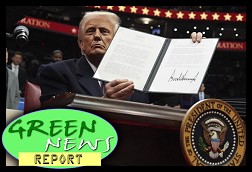 'Green News Report' 1/20/25
'Green News Report' 1/20/25
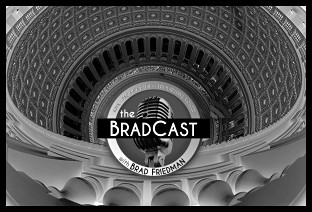 2025 Inauguration Counter-Programming Special:
2025 Inauguration Counter-Programming Special: Sunday 'Felonauguration' Toons
Sunday 'Felonauguration' Toons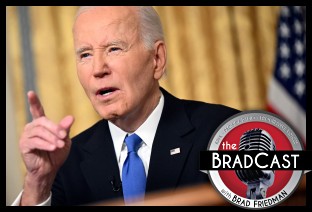 Fires, Liars and Oligarchs Rising as Biden Takes Final Bow, Issues Warning: 'BradCast' 1/16/25
Fires, Liars and Oligarchs Rising as Biden Takes Final Bow, Issues Warning: 'BradCast' 1/16/25 'Green News Report' 1/16/25
'Green News Report' 1/16/25 Does Trump's Sentencing as a Felon Matter?: 'BradCast' 1/15/25
Does Trump's Sentencing as a Felon Matter?: 'BradCast' 1/15/25 Hegseth Faces Dem Fire in Contentious, Constrained Senate SecDef Nom Hearing: 'BradCast' 1/14/25
Hegseth Faces Dem Fire in Contentious, Constrained Senate SecDef Nom Hearing: 'BradCast' 1/14/25 'Green News Report' 1/14/25
'Green News Report' 1/14/25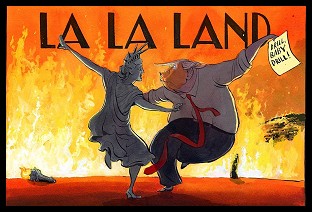 Sunday 'City of Angeles' Toons
Sunday 'City of Angeles' Toons Ordered to Evacuate, But Now Home Safe: 'BradCast' 1/9/25
Ordered to Evacuate, But Now Home Safe: 'BradCast' 1/9/25 'Green News Report' 1/9/25
'Green News Report' 1/9/25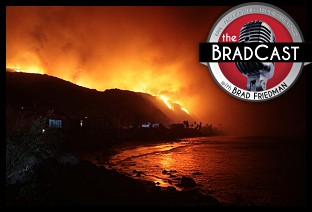 'A Tidal Wave of Fire' in L.A.:
'A Tidal Wave of Fire' in L.A.: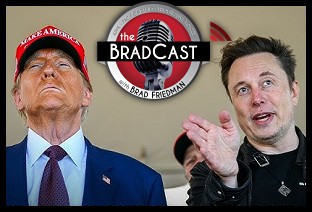 Trouble in Trumpland? Broligarchs v. MAGA!: 'BradCast' 1/7/25
Trouble in Trumpland? Broligarchs v. MAGA!: 'BradCast' 1/7/25 2025 Kicks Off With Both a Bang and a Whimper: 'BradCast' 1/6/25
2025 Kicks Off With Both a Bang and a Whimper: 'BradCast' 1/6/25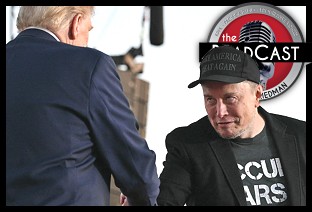 Trump Gets Trumped in Our Musky Year-End Roundtable: 'BradCast' 12/19/24
Trump Gets Trumped in Our Musky Year-End Roundtable: 'BradCast' 12/19/24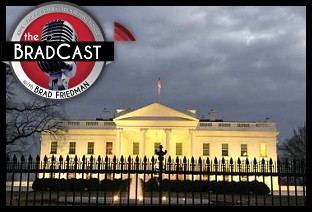 About Some of Trump's 'Day One' Threats: 'BradCast' 12/18/24
About Some of Trump's 'Day One' Threats: 'BradCast' 12/18/24 Trump Corruption Cometh... So Does Our Opposition: 'BradCast' 12/17/24
Trump Corruption Cometh... So Does Our Opposition: 'BradCast' 12/17/24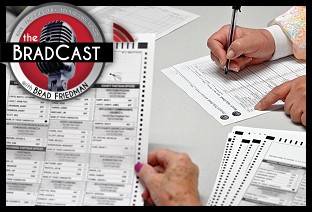 Mistallied Contests Found in OH County, as Oligarchy Rises in D.C.: 'BradCast' 12/16
Mistallied Contests Found in OH County, as Oligarchy Rises in D.C.: 'BradCast' 12/16 Trump Admits He Can't Lower Grocery Prices (Biden Just Did): 'BradCast' 12/12/24
Trump Admits He Can't Lower Grocery Prices (Biden Just Did): 'BradCast' 12/12/24
 VA GOP VOTER REG FRAUDSTER OFF HOOK
VA GOP VOTER REG FRAUDSTER OFF HOOK Criminal GOP Voter Registration Fraud Probe Expanding in VA
Criminal GOP Voter Registration Fraud Probe Expanding in VA DOJ PROBE SOUGHT AFTER VA ARREST
DOJ PROBE SOUGHT AFTER VA ARREST Arrest in VA: GOP Voter Reg Scandal Widens
Arrest in VA: GOP Voter Reg Scandal Widens ALL TOGETHER: ROVE, SPROUL, KOCHS, RNC
ALL TOGETHER: ROVE, SPROUL, KOCHS, RNC LATimes: RNC's 'Fired' Sproul Working for Repubs in 'as Many as 30 States'
LATimes: RNC's 'Fired' Sproul Working for Repubs in 'as Many as 30 States' 'Fired' Sproul Group 'Cloned', Still Working for Republicans in At Least 10 States
'Fired' Sproul Group 'Cloned', Still Working for Republicans in At Least 10 States FINALLY: FOX ON GOP REG FRAUD SCANDAL
FINALLY: FOX ON GOP REG FRAUD SCANDAL COLORADO FOLLOWS FLORIDA WITH GOP CRIMINAL INVESTIGATION
COLORADO FOLLOWS FLORIDA WITH GOP CRIMINAL INVESTIGATION CRIMINAL PROBE LAUNCHED INTO GOP VOTER REGISTRATION FRAUD SCANDAL IN FL
CRIMINAL PROBE LAUNCHED INTO GOP VOTER REGISTRATION FRAUD SCANDAL IN FL Brad Breaks PA Photo ID & GOP Registration Fraud Scandal News on Hartmann TV
Brad Breaks PA Photo ID & GOP Registration Fraud Scandal News on Hartmann TV  CAUGHT ON TAPE: COORDINATED NATIONWIDE GOP VOTER REG SCAM
CAUGHT ON TAPE: COORDINATED NATIONWIDE GOP VOTER REG SCAM CRIMINAL ELECTION FRAUD COMPLAINT FILED AGAINST GOP 'FRAUD' FIRM
CRIMINAL ELECTION FRAUD COMPLAINT FILED AGAINST GOP 'FRAUD' FIRM RICK SCOTT GETS ROLLED IN GOP REGISTRATION FRAUD SCANDAL
RICK SCOTT GETS ROLLED IN GOP REGISTRATION FRAUD SCANDAL VIDEO: Brad Breaks GOP Reg Fraud Scandal on Hartmann TV
VIDEO: Brad Breaks GOP Reg Fraud Scandal on Hartmann TV RNC FIRES NATIONAL VOTER REGISTRATION FIRM FOR FRAUD
RNC FIRES NATIONAL VOTER REGISTRATION FIRM FOR FRAUD EXCLUSIVE: Intvw w/ FL Official Who First Discovered GOP Reg Fraud
EXCLUSIVE: Intvw w/ FL Official Who First Discovered GOP Reg Fraud GOP REGISTRATION FRAUD FOUND IN FL
GOP REGISTRATION FRAUD FOUND IN FL


































